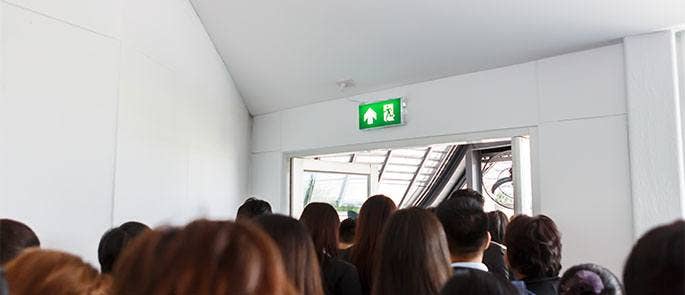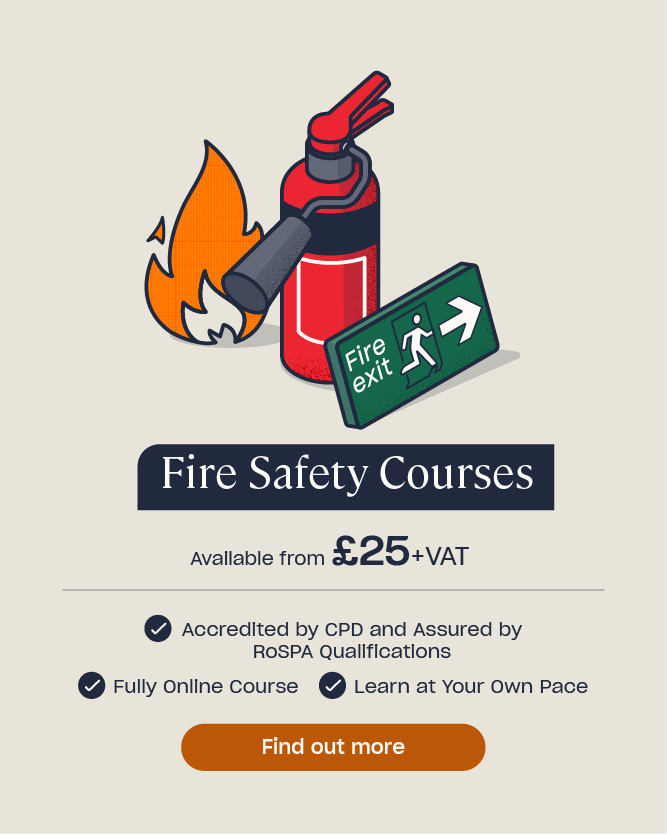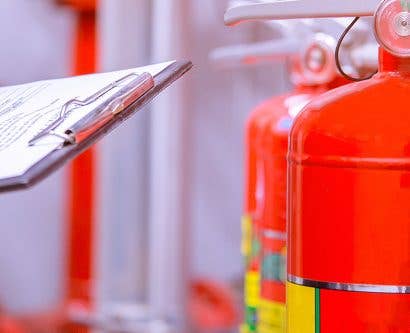Fire Safety Policy: Free Template
Anyone in charge of a building, whether a workplace, business or domestic premises, must ensure that a sufficient fire safety policy is written and implemented. This ensures the building has an adequate plan for what to do in case of a fire emergency and is an essential part of managing risk. In this article, we’ll look at what a fire safety policy is, how to write a fire safety policy, and provide you with a downloadable fire safety policy template that you can adapt for your own premises.
What is a Fire Safety Policy?
A fire safety policy is a written document that outlines how fire hazards in your premises will be managed and how you’ll protect people from fire should one occur.
By law, employers and people in charge of business and non-domestic premises must take steps to reduce the risks caused by fire. This means ensuring potential dangers are identified, fire safety responsibilities are clearly laid out and that there is a sufficient plan in place for what to do if a fire occurs. A fire safety policy is a simple way to ensure you have all of this information documented in one place.

The person responsible for creating the fire safety policy – the ‘responsible person’ – may be the employer, the building owner, the building’s landlord, an occupier of the building or someone else with control over the premises, like a facilities manager.
The responsible person must ensure that the fire safety policy is tailored to their specific building or buildings and protect everyone that might be present there, including workers, contractors, suppliers, members of the public and passers by.
Policies and Procedures for Fire Safety
The Regulatory Reform (Fire Safety) Order 2005 is the main piece of legislation governing fire safety in non-domestic and multi-occupancy buildings across England and Wales. It applies to all workplaces and all common parts of multi-occupancy domestic buildings, such as blocks of flats.
Under the Fire Safety Order, the responsible person – whether the employer, landlord, building owner or manager – must:
- Carry out a fire safety risk assessment for the premises.
- Ensure fire safety hazards are managed with appropriate fire safety measures.
- Assign fire safety responsibilities to named people, such as fire wardens.
- Train staff members in fire safety precautions.
- Create PEEPs for those who need them.
- Plan for what needs to happen in an emergency evacuation.
- Maintain the building’s general fire safety measures, such as fire extinguishers, emergency lighting, safety signage and fire doors.

The fire safety procedures for your premises will depend on the type of business, type and size of building and number of people present, but examples include:
- An adequate number of fire escape routes and means of escape, ensuring people are able to find their way out the building safely.
- Means of giving warning in case of fire, such as a fire alarm system and smoke detectors that are tested regularly.
- Clear fire safety signs and notices, indicating the location of fire exits and fire-fighting equipment.
- Suitable fire extinguishers, ensuring the right type of extinguisher is installed.
- Adequate emergency lighting, in case evacuation happens in the dark.
- A clear plan for what happens in case of emergency which is regularly tested through a fire drill.
If you are an employer, then it’s a good idea to share your fire safety responsibilities by nominating a fire warden or fire marshal who will work with you to ensure fire safety measures are in place and effective. All nominated fire wardens need to be given full training in fire safety, and their name and contact details should be shared with the whole business so everyone knows who to contact if fire safety hazards arise.
Looking to Learn More?
As an employer, it’s vital that all your employees are fully trained in fire safety measures so they know what to do in case of emergency. Our range of online Fire Safety Courses, including Fire Warden Training and Fire Risk Assessment Training, will provide members of staff at all levels with essential fire safety knowledge.
How to Write a Fire Safety Policy
Fire safety policies should always be tailored to your specific premises, as all businesses and buildings have different risks and different needs. There is no ‘one-size-fits-all’ policy that applies to everyone. Instead, you need to identify the fire safety risks, safety precautions and emergency procedures that are specific to your premises.
In general, a fire safety policy will contain a statement declaring the business’s commitment to fire safety and three main sections: an identification of the fire safety hazards, details of how these risks are avoided with relevant fire safety precautions and what should happen if a fire breaks out.
Fire Safety Policy Statement 
The first section of your fire safety policy should be a simple statement declaring your business’s commitment to fire safety, meeting legal requirements and ensuring people on the premises remain safe from harm. The statement should be signed and dated by the most senior person in your organisation to give it credibility.
A simple fire safety policy statement example is as follows:
“The purpose of this fire safety policy is to ensure the safety of all people in, or in the vicinity of, the premises in case of fire. The business is committed to taking all reasonably practicable measures to prevent or minimise the risk of fire and has undertaken a fire safety risk assessment to identify hazards and ensure appropriate controls are in place, in line with the Regulatory Reform (Fire Safety) Order 2005.
Whilst fire can never be prevented completely, the business has put in place suitable systems to alert people to fire, raise the alarm and escape safely. These systems will be regularly monitored and reviewed through fire drills. All members of staff will also be given training and instruction on fire evacuation measures.”
Section 1 – Identification of Fire Safety Hazards 
To write a fire safety policy, you’ll first need to identify all of the potential fire safety hazards around your premises. This means carrying out a fire safety risk assessment and making a written note of everything you discover that has the potential to start a fire or hinder a person’s escape during a fire. For example:
- Electrical equipment.
- Heating systems.
- Cooking facilities.
- Smoking.
- Combustible materials.
- Waste build-up.
- Building works.
- Poor housekeeping.
- Blocked escape routes.
Section 2 – Fire Safety Precautions 
This section should outline all of the fire safety procedures and arrangements your building/s has in place. It can be a simple checklist or contain more detailed information, depending on the level of risk identified and types of fire safety measures implemented. Examples of procedures and arrangements you may want to include are:
- Who in the premises has fire safety responsibilities and what they are.
- Means of detecting fires.
- Means of notifying people of a fire, i.e. fire alarm systems.
- How the fire detection and alarm systems are tested and when.
- How to raise the alarm, who can do this and where the fire alarm call points are located in the building.
- How the emergency services are contacted and by whom.
- Means of escape, including the location of fire exits, fire doors, evacuation routes, fire assembly points, emergency lighting, fire exit signage, etc.
- Fire evacuation procedures and information on how these are tested.
- Provision of PEEPs.
- Locations and types of fire-fighting equipment.
- Training and instruction given to employees, including extra training given to nominated fire wardens.
- Names and contact details of nominated fire wardens.
- The procedure for raising fire-related issues, concerns and near-misses.
- A copy of the most recent fire safety risk assessment.
Note that this list is not exhaustive and must be tailored to your own specific premises. You may also want to include a combination of written information, diagrams and maps, depending on your building’s arrangements.
Section 3 – Emergency Procedures 
This section of the fire safety policy should detail what must happen in case of a fire. It should include information such as:
- How the alarm should be raised.
- How people should respond when they hear the alarm, i.e. calmly, quickly and safely.
- The responsibilities of nominated fire wardens.
- Who will contact the emergency services and how.
- Where the fire assembly point/s is.
- How the evacuation plan will be communicated to staff through training and fire drills.
Fire Safety Policy Template
Use the link below to download a blank fire safety policy template that you can adapt for your own premises. Note that the pre-filled information in each section is an example only and must be tailored to your own individual building, people and needs.
A sufficient and regularly-reviewed fire safety policy is an essential part of risk management for all types of workplaces, buildings and premises. The responsible person in charge of fire safety for the premises must create a fire safety policy that covers all aspects of the building and the people in it to ensure everyone is kept safe and can evacuate safely in case of fire.











